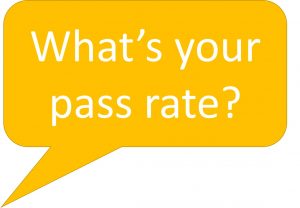The MSA GB has always fought against the publication of individual Approved Driving Instructor (ADI) pass rates, on the basis that the data differences make both correlation and therefore sensible comparison, of data, virtually impossible.
Considering the relatively small number of tests per instructor it is unlikely, from a statistical point of view, that it would be possible to produce reliable statistics even if a complicated algorithm were to be developed to try to cover all the variables.
As I understand it the chi-squared test, used to keep a check on examiner variances relies on a large sample. In a year a driving examiner probably conducts around one thousand five hundred driving tests. A driver trainer is unlikely to take more than fifty pupils for test in a year and probably less.
Age of candidate, gender of candidate, auto or manual gears, location of test centre; all these make for large differences in the stats recorded – as do unknown variables such as a pupil who ISN’T ready for the test exercising their democratic right to put themselves in for it anyway, as they are off to uni in a couple of weeks and they’d like to get it sorted out now, thanks very much.
Computer geeks – pull together an algorithm for that one
In the examples below I have rounded the decimals. The data is all extracted from Department for Transport (DfT) and Driver and Vehicle Testing Agency (DVSA) data sets and from a Freedom of Information (FOI) request. Each example illustrates the difficulty of providing a fair rating for an instructor based on available data.
I have also made some suggestions (IN BOLD) as to actions an instructor might take to improve their pupil pass rate.
___________________________
Current overall pass rate 47% Male 51% Female 44%
Current overall pass rate (automatic) 40% Male 44% Female 38%
So, don’t teach Female pupils in automatics.
___________________________
Current overall pass rate 17 year olds 57% Male 58% Female 55%
Current overall pass rate 25 year olds 46% Male 51% Female 43%
So, don’t teach anyone over 17 years old.
___________________________
Highest overall pass rates for one group – 17-year olds taking their fourth test.
So, advertise for 17 year old clients who have already failed three driving tests.
___________________________
These centres are all in North London and are within about 5 miles of each other
| DTC | First time Pass Rate |
| Wanstead | 32% |
| Chingford | 36% |
| Barnet | 38% |
| Wood Green | 38% |
| Enfield | 40% |
| Mill Hill | 43% |
So, if you live in North London take your pupils to Mill Hill.
___________________________
These centres in Greater Manchester are either inside the M60 or less than a couple of miles outside it.
| DTC |
First time |
| Cheetham Hill | 30% |
| Failsworth | 36% |
| West Didsbury | 43% |
| Bredbury | 48% |
| Sale | 50% |
| Hyde |
62% |
So, if you live in Greater Manchester and usually use Cheetham Hill stop, take your pupils for test in Hyde they are twice as likely to pass first time.
___________________________

Although there is nothing the ADI can do about it, the route taken for each test can affect the pass rate by as much as 13% as this information extracted from an FOI request shows.
The table below shows the pass and fail rates by test route for car practical driving tests conducted at Darlington driving test centre between 1 January 2012 and 31 December 2014. This data is only for routes where more than 10 tests have been conducted.
|
Route Number |
No. tests conducted | Failed tests | %Pass |
| 7 | 896 | 505 | 43.6% |
| 8 | 724 | 406 | 43.9% |
| 15 | 697 | 380 | 45.5% |
| 6 | 838 | 451 | 46.2% |
| 14 | 672 | 359 | 46.6% |
| 16 | 30 | 16 | 46.7% |
| 1 | 940 | 494 | 47.4% |
| 4 | 767 | 400 | 47.8% |
| 5 | 736 | 379 | 48.5% |
| 10 | 716 | 364 | 49.2% |
| 11 | 641 | 313 | 51.2% |
| 12 | 666 | 320 | 52.0% |
| 99 | 25 | 12 | 52.0% |
| 2 | 837 | 398 | 52.4% |
| 13 | 654 | 296 | 54.7% |
| 9 | 750 | 337 | 55.1% |
| 3 | 838 | 368 | 56.1% |
___________________________
Then of course there is the luck of the draw as to which examiner you take as this second extract from the same FOI request indicates
The table below shows the pass rate statistics for examiners who are permanently based at Darlington test centre between 1 January 2012 and 31 December 2014.
This has been supplied in an anonymised format as we do not release pass and fail rates by named examiner. Information about named individuals is exempt from release under section 36(2)(c) on the grounds that its disclosure would prejudice the effective conduct of public affairs, a view certified by the Minister and then subject to the public interest test as to whether the balance lies in favour of withholding or disclosing the information. We have concluded, applying a presumption in favour of disclosure, and in all the circumstances of the case, the public interest in maintaining the exemption outweighs the public interest in disclosing the information.
| Examiner | No. tests conducted | Failed tests | %Pass |
|
Examiner 3 |
882 | 481 |
45.5% |
|
Examiner 4 |
2,508 | 1,347 |
46.3% |
|
Examiner 7 |
2,313 | 1,237 |
46.5% |
|
Examiner 1 |
1,561 | 780 | 50.0% |
| Examiner 8 | 229 | 112 |
51.1% |
|
Examiner 5 |
1,837 | 872 | 52.5% |
|
Examiner 6 |
1,631 |
768 |
52.9% |
| Examiner 2 | 233 | 95 |
59.2% |
___________________________
Publication of ADI pupil pass rates would be as meaningless as publishing individual examiner pass rates or the pass rate per route at a particular test center.
Now would be a good time for the DVSA to make it very clear that they do not intend to publish ADI pass rates.


As you know John, I have always been extremely against publishing individual Instructors pass rates, especially as I teach female over 30 in automatics I’m doomed. The only way would be if individual examiner’s pass rates were also published, in conjunction with the candidates ability to choose which examiner conducted the test, so those examiner’s with lower pass rates could be weeded out of the system.
Thanks for your comment Haydn as I wrote in the blog it is unlikely that it would be possible to produce reliable statistics even if a complicated algorithm were to be developed to try to cover all the variables.
And the pass rates for ADIs specialising in teaching learners with specific learning needs is…??? and I do believe some will stop teaching this group if pass rates are published. Just like school league tables, pass rates do not reflect the full picture.
Thanks Jackie. DVSA do not appear to keep statistics of pupils with specific learning needs. However, I’m told anecdotally that their pass rates are pretty much in line with their peers who do not have those specific needs. I have never seen evidence that those with specific learning needs have a lower pass rate.
Very well put!! Thank you!
Thank you Richard
I agree with your comments , I am not long doing the job and have had varying results had a mixture of first time , second third and fourth time passes .
Each pupil is individual I always make sure they are ready for test but my best driver might fail and someone who sometimes Macmillan be more nervous is the one that passes first time . I also find inconsistencies with the examiners sometimes they are more lenient towards a pupil . It’ wouldn’t be fair to publish our pass rates
Thanks for your comments
Having been a driving instructor for over thirty years
I have a very up and down pass rate but in my opinion the main factor that affects a pupil on test day is nerves. As your data has shown 4th test has the highest pass rate, this could be simply that by the 4th test they have settled down enough to drive without making stupid mistakes due to their nerves.
In all the years I’ve been doing the job I’ve never taken a pupil for test that is not capable of passing.
So how would publishing pass rates of any sort be constructive or beneficial?
Thanks your comment, is spot on I think publishing pass rates would not be constructive or beneficial.
Hi John
I wanted to thank you for writing this. As you may recall from the days when I was in a position to sit around a table with you in NASP, I have never been in favour of the use of individual pass rates for comparative or KPI purposes, for much the same reasons as you outline, and it is refreshing to see you publish your basis for rejecting them, with a little humour for good measure! I do hope that the MSA will robustly reject any continuing or future move by DVSA to use pass rate data in this or a similar way.
Hi Gareth YOU are missed around the table – thanks for your support.